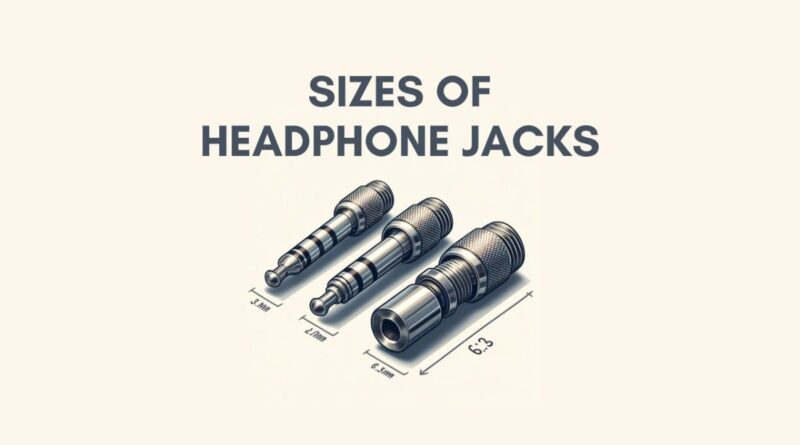Different Sizes Of Headphone Jacks – A Detailed Guide
Have you ever gotten excited about a new pair of headphones, only to find they don’t fit your device? Or maybe you’re looking at a vintage amplifier and wondering what kind of headphones you’ll need. The culprit behind this confusion? The headphone jacks, which come in a surprising array of sizes. This guide will talk about the different sizes of headphone jacks, and more. We’ll cover the three most common sizes: 2.5mm, 3.5mm, and 6.35mm, along with information on how to identify the right jack for your needs. Whether you’re a seasoned audiophile or a casual listener, this guide will ensure your headphones and device are always on the same page – or should we say, jack!
The Evolution of Headphone Jack Technology
The headphone jack, a seemingly simple piece of tech, boasts a surprisingly long and interesting history. Here’s a breakdown of its evolution:
- Early Days (1878): The story starts in the 19th century with the quarter-inch jack (6.35mm). This bulky connector was used on telephone switchboards to manually connect calls.
- Miniaturization (1950s): As technology embraced smaller devices, the need for a compact audio solution arose. The answer came in the form of the 3.5mm jack, a miniaturized version of its predecessor. This coincided with the rise of portable transistor radios, making headphones a more accessible accessory.
- The Walkman Era (1979): The invention of the Sony Walkman in 1979 truly cemented the 3.5mm jack’s place in history. This portable music player, along with cassette and later CD players, relied on this jack for headphone connection, making it the industry standard for personal audio.
- The Reign of the 3.5mm Jack (Late 20th – Early 21st Century): For decades, the 3.5mm jack remained unchallenged. It was universally accepted, easy to use, and offered decent audio quality. It found a home on everything from portable music players to smartphones and laptops.
- The Potential Demise (2010s): In the late 2010s, whispers of the 3.5mm jack’s demise began. Smartphone manufacturers, like Apple with the iPhone 7 in 2016, started ditching the headphone jack in favor of slimmer designs and a push towards wireless solutions like Bluetooth headphones.
- The Current Landscape (2020s): Today, the 3.5mm jack’s presence is declining, particularly in high-end smartphones. However, it’s still found on many mid-range devices and other electronics. Wireless headphones continue to rise in popularity, but the 3.5mm jack retains a loyal following who appreciate its universality, wired reliability, and audio quality.
Sizes Of Headphone Jacks
Headphone jacks come in different sizes to accommodate various audio devices. The most common sizes include:
- 6.35mm (1/4 inch) jack: This larger-sized jack is commonly used in professional audio equipment and high-end headphones. It provides a robust connection and is known for its superior sound quality.
- 3.5mm (1/8 inch) jack: Also known as the standard audio jack, this size is widely used in consumer electronics like smartphones, laptops, and portable music players. It offers a compact and versatile solution for audio connectivity.
- 2.5mm jack: This smaller-sized jack is less common but can still be found in some older devices. It is often used in specific audio equipment or older models of smartphones.
It’s important to note that not all devices support all headphone jack sizes. Before purchasing headphones or audio equipment, make sure to check the compatibility with your device’s headphone jack size.
Types of Headphone Jacks
In addition to different sizes, headphone jacks can also have different types of connectors. The two most common types are:
- TRS (Tip-Ring-Sleeve): This type of connector has three sections, with the tip carrying the left audio channel, the ring carrying the right audio channel, and the sleeve serving as the ground connection. TRS connectors are commonly used in stereo headphones.
- TRRS (Tip-Ring-Ring-Sleeve): It has an additional ring, allowing it to carry both audio channels and an additional connection for microphone input. TRRS connectors are commonly used in headphones with built-in microphones or for audio input/output in smartphones and laptops.
Compatibility with Devices
When it comes to headphone jack compatibility, it’s important to consider the device you intend to use the headphones with. While the 3.5mm (1/8 inch) jack is the most common and widely supported, there are some devices that may not have a headphone jack at all.
Modern smartphones, for example, have started removing the headphone jack in favor of wireless audio or USB-C/Lightning connectors. In such cases, you may need a headphone adapter or wireless headphones to connect to your device.
It’s also worth noting that some devices may have proprietary connectors or use different jack sizes, especially in professional audio equipment. Always check the compatibility of your headphones or audio equipment with your device before making a purchase.
Tips for Choosing the Right Headphone Jack Size
When selecting headphones or audio equipment, it’s important to consider the right headphone jack size for your device. Here are some tips to help you make the right choice:
- Check the specifications: Review the specifications of your device to determine the supported headphone jack size. This information can usually be found in the user manual or on the manufacturer’s website.
- Use adapters: If your device has a different headphone jack size than your headphones or audio equipment, consider using an adapter to ensure compatibility. Adapters are available for various jack sizes and connector types.
- Consider wireless options: If your device doesn’t have a headphone jack or you prefer a wireless experience, consider investing in wireless headphones or earbuds. Bluetooth technology allows for seamless audio connectivity without the need for physical jacks.
Future of Headphone Jack Technology
As technology continues to evolve, the future of headphone jack technology remains uncertain. With the increasing popularity of wireless audio and the removal of headphone jacks from some devices, it’s possible that wired connections may become less common in the future.
However, there will likely still be a demand for wired audio connectivity, particularly in professional audio settings and for audiophiles who value high-fidelity sound. Manufacturers may continue to innovate and improve wired headphone jack technology to cater to these specific needs.
Additionally, advancements in wireless audio technology, such as Bluetooth codecs and low-latency transmission, may further enhance the wireless audio experience, making it a viable alternative to wired connections. Ultimately, the future of headphone jack technology will be shaped by consumer preferences, technological advancements, and the needs of different audio applications.
Frequently Asked Questions
How many sizes of headphone jacks are there?
There are three main headphone jack sizes: 2.5mm, 3.5mm, and 6.35mm.
What is the most common headphone jack size?
The 3.5mm jack is the most common size for portable devices like smartphones and MP3 players.
What size jack is better, 3.5mm or 6.35mm?
The 6.35mm jack is generally considered to provide better sound quality, but it’s larger and more suited for professional audio equipment. The 3.5mm jack offers a good balance of sound quality and portability.
What devices use 2.5mm headphone jacks?
The 2.5mm jack is less common but can be found on some older mobile phones and two-way radios.
Can I use headphones with a different size jack than my device?
Yes, you can use adapters to connect headphones with a different jack size to your device. For example, a 6.35mm to 3.5mm adapter would allow you to use headphones with a larger jack on a device with a smaller jack.
Do headphone jack sizes affect sound quality?
Yes, larger jacks like 6.35mm can potentially offer better sound quality due to a more stable connection. However, other factors like the quality of the headphones themselves and the audio source also play a significant role.
Are headphone jacks becoming obsolete?
With the rise of wireless headphones and Bluetooth connectivity, headphone jacks are becoming less common on some devices, especially smartphones. However, they are still widely used and many devices still have them.
What are the advantages of headphone jacks?
Headphone jacks provide a reliable wired connection that doesn’t rely on batteries or Bluetooth pairing. They can also be more affordable than wireless headphones.
What are the disadvantages of headphone jacks?
Headphone jacks can be bulky and limit your movement when using headphones. They can also become loose or damaged over time.
Should I consider the headphone jack size when buying new headphones?
If you have a specific device in mind that you’ll be using the headphones with, then yes, it’s important to check the headphone jack size to ensure compatibility. Otherwise, the 3.5mm jack size is the most versatile option.




